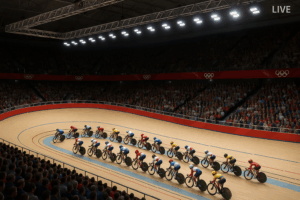In filmmaking, lighting plays a critical role in shaping the final product. Traditionally, motion capture, particularly in high-speed cinematography, has posed unique challenges for filmmakers. The need to perfectly capture high-speed action—be it an athlete’s sprint, a bullet’s trajectory, or a fighter’s intricate movements—demands lighting that not only illuminates the subject but also does so without introducing motion blur or sacrificing clarity. Conventional lighting techniques often fail to meet the requirements of fast-paced scenes, leading to undesirable results like streaking or an inability to capture fine details at high frame rates.
In recent years, high-speed LED lighting has emerged as a game-changer. Offering precise control, flicker-free operation, and consistent brightness at high frame rates, these advanced LEDs have revolutionized the way cinematographers approach fast-moving scenes. This article explores how high-speed LED lights are pushing the boundaries of cinematic motion capture, enabling filmmakers to achieve breathtaking visuals that were once difficult, if not impossible, to capture.
High-speed motion capture is a specialized aspect of filmmaking used to record extremely fast movements with incredible precision. Whether it’s the split-second movements of a race car, the dynamic action of a fight scene, or the fluid motions in a slow-motion sequence, capturing these moments accurately requires specialized technology and techniques.
A traditional camera filming at a standard frame rate (24fps) might not be sufficient to fully capture fast-moving objects. For example, at high frame rates (500-1000 fps or higher), the camera takes many more frames per second, which can cause challenges with lighting, as each frame needs to be evenly illuminated and free of flicker to maintain smooth motion. The faster the motion, the more crucial the lighting becomes.
High-speed LED lighting solves this problem by offering a consistent light output at high shutter speeds, which are essential for slow-motion filming. Unlike traditional tungsten or fluorescent lights, LEDs can be adjusted to sync with the camera’s frame rate, ensuring that each frame is illuminated with no flicker or strobing.
High-speed LEDs are engineered for optimal performance in high-speed cinematography. The primary difference between standard LEDs and high-speed LEDs is their ability to operate without flickering under intense conditions. Flicker in lighting is caused by the alternating current (AC) cycle of traditional lights, which does not match the frame rate of high-speed cameras. High-speed LEDs, on the other hand, use advanced pulse width modulation (PWM) that allows them to maintain consistent light output even at extremely high frame rates.
The key science behind high-speed LEDs involves controlling the speed at which the light source can change its intensity. This rapid response time ensures that high-speed motion can be captured clearly, without creating a strobe effect or leaving trails in the shot. Additionally, high-speed LEDs maintain color temperature stability across a wide range of intensities, a crucial feature for high-quality cinematic visuals.
When filming at very high frame rates (e.g., 1000 fps or more), standard lights often fail to provide enough illumination during the brief exposure time of the camera. High-speed LEDs solve this problem by maintaining brightness and color consistency over short periods, allowing for sharp, clear images even under intense motion.
High-speed LEDs offer several distinct advantages over traditional lighting techniques in motion capture. Here are some of the key benefits:
Flicker-Free Lighting
One of the most significant challenges in high-speed cinematography is ensuring flicker-free lighting. Flicker can cause motion blur and distort the image, especially when filming at high frame rates. Traditional lights, such as incandescent or halogen bulbs, often flicker at higher frame rates, resulting in poor image quality. High-speed LEDs are specifically designed to operate without flicker, ensuring clean and crisp images even at extreme frame rates.
Brightness and Color Consistency
High-speed LEDs maintain consistent brightness and color temperature, which is essential when shooting fast-moving subjects. Traditional lights may vary in output as they heat up, affecting the color consistency of the shot. High-speed LEDs, however, deliver a stable output throughout the shoot, ensuring that the lighting remains uniform and accurate across all frames.
Low Power Consumption
Compared to traditional incandescent or halogen lighting, high-speed LEDs are more energy-efficient. Their lower power consumption makes them ideal for long-duration shoots, especially in large-scale productions where lighting can be a major power draw. This energy efficiency is critical for both the environment and the production budget, allowing filmmakers to light complex scenes without worrying about high electricity costs.
Durability and Precision
High-speed LEDs are highly durable, providing long-lasting performance with minimal maintenance. They also allow for precise control over light intensity, direction, and diffusion. This level of control is crucial in high-speed filming, where even the smallest variation in light can affect the quality of the shot. The ability to fine-tune these parameters gives cinematographers unprecedented flexibility in creating the desired visual effect.
High-speed LED lighting has found numerous applications in various cinematic techniques, particularly in high-speed or slow-motion filmmaking. Here are a few key examples:
Action Sequences
In action movies, high-speed LED lighting is used to capture fast-paced scenes such as car chases, explosions, and fight choreography. The ability to maintain consistent lighting without flicker ensures that every frame of the action is sharp and clear, giving the audience a seamless and realistic experience.
Sports Filming
Capturing the dynamic movement of athletes requires precise lighting that can keep up with their speed. High-speed LEDs are used to illuminate athletes in motion, ensuring that every quick movement, whether it’s a football player sprinting or a tennis player hitting a serve, is perfectly lit. This level of clarity allows the audience to appreciate the athleticism on screen in full detail.
Slow-Motion Shots
Slow-motion cinematography relies on high-speed cameras to capture fast-moving objects or people at a slower pace. To avoid stuttering or ghosting effects in these shots, high-speed LEDs are crucial. By providing consistent and flicker-free light at high frame rates, LEDs ensure that slow-motion sequences appear smooth and lifelike, with no loss of detail.
Strobing and Light Streak Effects
High-speed LEDs can be used creatively to generate strobe effects, often seen in action sequences or experimental filmmaking. The ability to control the frequency and intensity of the light pulses allows filmmakers to create dramatic lighting effects that enhance the action and contribute to the overall atmosphere of the scene.
Several well-known films and TV shows have utilized high-speed LED lighting to enhance their action and slow-motion sequences. For instance, in The Matrix Reloaded, filmmakers used high-speed LED lights to illuminate the famous freeway chase scene. The precise control over lighting ensured that each bullet and each movement was captured in crystal-clear detail, contributing to the iconic visual style of the film.
Another example is the Fast & Furious franchise, where high-speed LEDs were used in multiple car chase sequences. The combination of high-speed cameras and flicker-free LEDs allowed cinematographers to achieve smooth motion capture during high-speed scenes, giving audiences a thrilling and immersive experience.
The development of high-speed LED technology has been driven by innovations in electronics and materials science. Today’s LEDs are not only brighter and more energy-efficient but also faster and more adaptable than ever before.
Recent advancements in Pulse Width Modulation (PWM) and smart control systems have made it easier for filmmakers to synchronize high-speed LEDs with camera frame rates, providing precise control over lighting in dynamic environments. Additionally, advancements in heat management technology have made it possible to use high-power LEDs without compromising performance or safety.
In the coming years, we can expect even more sophisticated high-speed LED systems. For example, AI-controlled lighting setups that automatically adjust light intensity based on motion or scene requirements could further streamline the filmmaking process.
While high-speed LEDs offer numerous advantages, there are still some challenges and limitations to consider:
Cost and Accessibility
High-speed LED lights can be more expensive than traditional lighting setups, which can be a barrier for smaller productions or independent filmmakers. The initial investment in high-speed LED equipment can be substantial, though the long-term savings in energy consumption and maintenance can offset this cost.
Compatibility with Existing Systems
Integrating high-speed LEDs with older lighting setups or other high-tech equipment can sometimes pose compatibility issues. Filmmakers may need to invest in additional control systems or adapters to ensure seamless integration.
Heat Generation and Ventilation
While LEDs are more energy-efficient than traditional lights, they still generate heat, particularly when used in high-power settings. Proper ventilation and heat dissipation systems are essential to maintain the longevity of the lights and prevent overheating.
To maximize the benefits of high-speed LED lighting, cinematographers should follow some best practices:
High-speed LED lighting has dramatically improved the quality of motion capture in filmmaking, enabling filmmakers to capture fast-paced action and intricate details with precision and clarity. As technology continues to evolve, we can expect even more powerful and efficient high-speed LEDs that push the boundaries of what is possible in cinematic motion capture.
By offering consistent brightness, flicker-free operation, and energy efficiency, high-speed LEDs are revolutionizing the way filmmakers approach fast-moving scenes. As the demand for high-quality motion capture grows, so too will the role of high-speed LEDs in shaping the future of filmmaking.
–The End–
Get in touch for free lighting customization